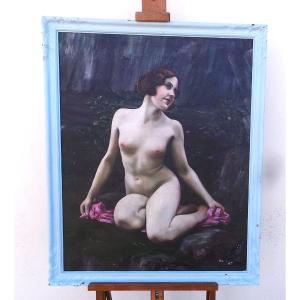Astrea leaves the earth at the end of the Bronze Age
Oil on panel, cm 45 x 38
In mythology, Astrea (also called Dike), daughter of Zeus and the titan Temi, was one of the Hours: the goddess protected the courts and was an inflexible punisher of crimes. Ancient Greek legends tell that the Goddess wanted to come down to earth in the Golden Age, a period of eternal spring, when men did not need to work because the land spontaneously produced its fruits and peace and justice reigned supreme. All this was happening under the reign of Cronos (Saturn), but when he was killed by his younger son Zeus (Jupiter), the seasons began to follow and men had to struggle to live: this led to the birth of the first conflicts between men and Gods, Starting the Silver Age, where Astrea took responsibility for warning men and leading them on the right path. Unfortunately, her efforts were in vain, so she withdrew from humanity, over high mountains, and predicted a more dark future for men. The Bronze and Iron Ages followed, when human wickedness no longer knew any brakes. Bitter and disgusted, Astrea decided to leave for good, flying with her black wings among the shining stars, from where, more and more sad, she watched the spread of men’s meanness. As Ovid narrates in his Metamorphoses: «The goodness lies vanquished, and the virgin Astrea, last of the gods, leaves the earth moth-ed with blood» (Publio Ovidio Nasone, Le metamorfosi, I, vv. 149-150). The mythological figure of Astrea, mysterious and unknown, attracted the attention of various literati and intellectuals from the Renaissance to the modern age: in the sixteenth century, Ludovico Ariosto, in the furious Orlando, describes the emperor Carlo V as him, that unifying all the kingdoms of Christianity, would have brought back again the goddess of justice on Earth; in 1816 the poet Vincenzo Monti composed a poem, Il ritorno di Astrea, which played on the assonance between Astrea and Austria, Who returned to dominate Milan after the Napoleonic parenthesis. If the character is rediscovered in literature, this cannot be said for painting and decorative arts: the iconographic theme of Astrea’s flight from the earth - often proposed by Greek craftsmen in relation to vascular painting - was little frequented both in the Renaissance and in the Baroque era: one of the rare cases of this topos is found in the Throne Room of the Reggia di Caserta, where it finds a high relief in carrara marble that presents the Hellenic deity with its canonical attributes.
The painting in question depicts the moment when the goddess, discouraged by the violence and wickedness that enshrouds men on earth, decides to turn away from them, to take refuge among the stars in the peace and quietness of the night sky. The metallic wings of the angel in the lower section of the composition also refer to the passage of the world from the glorious ages of gold and silver to the violent ages of bronze and iron.








































 Le Magazine de PROANTIC
Le Magazine de PROANTIC TRÉSORS Magazine
TRÉSORS Magazine Rivista Artiquariato
Rivista Artiquariato